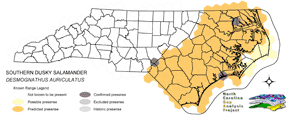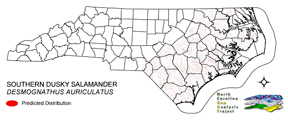
| Taxa: |
| Order: |
| Family: |
| Amphibia |
| Caudata |
| Plethodontidae |
| NatureServe Global Rank: |
| NatureServe State (NC) Rank: |
| G5 |
| S5 |
| Federal Status: |
| NC State Status: |
| --- |
| --- |


| Land Unit |
| US Fish & Wildlife Service |
| US Forest Service |
| US National Park Service |
| US Department of Defense |
| NC State Parks |
| NC University System |
| NC Wildlife Res. Com. |
| NC Forest Service |
| NC Div. of Coastal Mgmt. |
| Local Governments |
| Non-Governmental Org. |
| Other Public Lands |
| Private Lands |
| GAP Status 1-2 |
| All Protected Lands |
| Statewide |
| Hectares |
| 7,735.32 |
| 2,928.51 |
| 6,462.54 |
| 2.88 |
| 1,862.28 |
| 571.77 |
| 2,869.20 |
| 412.02 |
| 514.26 |
| 30.06 |
| 1,239.75 |
| 28.71 |
| 209,830.50 |
| 13,272.57 |
| 24,580.80 |
| 234,487.80 |
| Acres |
| 19,114.39 |
| 7,236.50 |
| 15,969.28 |
| 7.12 |
| 4,601.79 |
| 1,412.87 |
| 7,089.95 |
| 1,018.12 |
| 1,270.76 |
| 74.28 |
| 3,063.49 |
| 70.94 |
| 518,502.36 |
| 32,797.23 |
| 60,740.47 |
| 579,431.86 |
| % of Dist. on |
| Prot. Lands |
| 31.5 % |
| 11.9 % |
| 26.3 % |
| < 0.1 % |
| 7.6 % |
| 2.3 % |
| 11.3 % |
| 1.7 % |
| 2.1 % |
| 5.0 % |
| 5.0 % |
| < 0.1 % |
| 0.1 % |
| 54.0 % |
| ----- |
| ----- |
| % of Dist. on |
| All Lands |
| 3.3 % |
| 1.2 % |
| 2.8 % |
| < 0.1 % |
| 0.8 % |
| 0.2 % |
| 1.2 % |
| 0.2 % |
| 0.2 % |
| < 0.1 % |
| 0.5 % |
| < 0.1 % |
| 89.5 % |
| 5.7 % |
| ----- |
| ----- |
|
Found in the coastal plain (Petranka 1998). Primarily found in moist well-shaded deciduous forests adjacent to slow-moving perennial creeks or acidic stagnant bottomland waters (Petranka 1998). It prefers muddy substrates (Petranka 1998). Uncommon in sandy soil or pine forest. This salamander is found in moderate to dense leaf litter and dead & decaying wood during all life stages. NATURE SERVE GLOBAL HABITAT COMMENTS: Mucky areas near springs, swamps, cypress heads, mud-bottomed streams, floodplain pools, and ravine streams where pockets of organic debris collect; usually in or near moving water. Environment usually acidic. Hides under leaves, logs, or debris or in burrows during day. Eggs are laid under or in logs or in depressions under moss or other cover near water. |
| Code | Name | Description | NC Natural Heritage Program Equivalent |
| 50 | Coastal Plain Mixed Bottomland Forests | Includes forests dominated by a variety of hardwood species, including sweetgum, cottonwood, red maple. | Coastal Plain Bottomland Hardwood (in part), Coastal Plain Levee Forest |
| 49 | Coastal Plain Oak Bottomland Forest | Bottomland forests dominated by deciduous oak alliances. Oaks represented can include swamp chestnut, cherrybark, willow, and/or overcup oak. Inclusions of loblolly pine temporarily flooded forests occur in patches. Hydrology is temporarily to seasonally flooded. | Coastal Plain Bottomland Hardwoods (in part) blackwater subtype, brownwater subtype |
| 158 | Coastal Plain Nonriverine Wet Flat Forests | Loblolly pine - Atlantic white-cedar - red maple - swamp tupelo saturated forests as well as forests dominated by loblolly, sweetgum, and red maple in non-riverine flats. | Non-riverine Wet Hardwood Forest |
| 15 | Seepage and Streamhead Swamps | Includes extensive peat flats in the coastal plain, dominated by swamp tupelo, maples, and Atlantic white cedar alliances. In the sandhills includes streamhead pond pine and bay forests alliances. Saturated hydrology. | Bay Forest, Small Depression Pocosin, Streamhead Atlantic White Cedar Forest, Streamhead Pocosins |
| 30 | Cypress-Gum Floodplain Forests | Swamps dominated by black or swamp tupelo with or without Taxodium. Seasonally to semi-permanently flooded hydrology. | Cypress-Gum Swamps |
| 78 | Pond-Cypress - Gum Swamps, Savannas and Lakeshores | Cypress dominated swamps and lakeshores. Can include bays dominated by pond cypress or shorelines of coastal plain lakes with a narrow band of cypress. | Non-riverine Swamp Forest, Natural Lakeshores (in part) |
| 385 | Oak Bottomland Forest and Swamp Forest | The swamp chestnut oak, cherrybark oak, shumard oak and sweetgum alliance is one representative. Other alliances are dominated by water, willow, and overcup oaks. Swamp forests can be dominated by sweetgum, red maple, and black gum being dominant. Loblolly can occur in combination with sweetgum and red maple, or with tulip poplar. Includes saturated and semi- to permanently flooded forests in the mountains. | Piedmont/Mountain Bottomland Forest, Piedmont/Mountain Swamp Forest |
| 87 | Pocosin Woodlands and Shrublands | Includes pond pine woodland, low pocosin and high pocosin shrub dominated areas. Canebrakes and bay forests may be present. | Pond Pine Woodlands, Peatland Canebrake, Small Depression Pocosin |
| 384 | Piedmont/Mountain Mixed Bottomland Hardwood Forests | Includes temporarily to seasonally forests dominated by hardwood species. Hardwoods include sweetgum, red maple, sycamore which co-occur in a mosaic of bottomland and levee positions. Includes alluvial hardwood forests in the mountains. Hemlock and white pine may occur as inclusions, but are generally mapped separately. | Piedmont/Mountain Alluvial Forest, Piedmont/Mountain Levee Forest |
|
Petranka, J. W. 1998. Salamanders of the United States and Canada. Washington DC: Smithsonian Inst. Press.
Mount, R. H. 1975. The Reptiles and Amphibians of Alabama. Auburn University Agricultural Experiment Station, Auburn, Alabama. vii + 347 pp. Behler, J. L., and F. W. King. 1979. The Audubon Society field guide to North American reptiles and amphibians. Alfred A. Knopf, New York. 719 pp. Martof, B. S., W. M. Palmer, J. R. Bailey, and J. R. Harrison, III. 1980. Amphibians and reptiles of the Carolinas and Virginia. University of North Carolina Press, Chapel Hill, North Carolina. 264 pp. |
For more information please contact them at:
NC-GAP Analysis Project
Dept. of Zoology, NCSU
Campus Box 7617
Raleigh, NC 27695-7617
(919) 513-2853
www.basic.ncsu.edu/ncgap